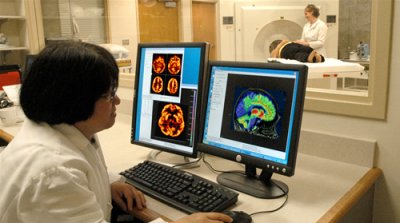positron emission tomography (PET) scanning

Positron emission tomography. The patient is drip-fed a radioactive chemical (1) that works its way around the body. The scanner (2) emits low-energy gamma radiation (3) to the areas of the body under examination. The gamma radiation causes the radioactive chemical in the blood supply (4) to emit detectable photons (5) which are interpreted by computer software () to show how that part is functioning. As the scanner moves along the body cross-sections of the organ, in this example the brain, can be viewed (7).

PET scanner. Credit: Yale University.
Positron emission tomography (PET) scanning is a medical diagnostic technique based on the detection of positrons emitted by labeled substances introduced into the body. PET scanning produces three-dimensional images that reflect the metabolic and chemical activity of tissues being studied. PET images therefore give in-formation about function as well as structure.
How PET scanning works
Substances that take part in biochemical processes in the body are labeled with radioisotopes (radioactive forms of elements, such as carbon-11, nitrogen-13, or oxygen-15). These substances are injected into the bloodstream and are taken up in greater concentrations by areas of tissue that are more metabolically active. In the tissue, the substances emit positrons, which, in turn, release photons (particles of light). It is the detection of these photons that actually forms the basis of PET scanning.
By surrounding the patient with an array of detectors linked to a computer, the origin of the photons can be computed and a picture built of the distribution of the radioisotope.
What PET scanning is used for
PET scanning is particularly valuable for investigating the brain. It is used for detecting tumors (which are more or less metabolically active than surrounding tissues), for locating the origin of epileptic activity within the brain, and for beaming brain function in various mental illnesses.


